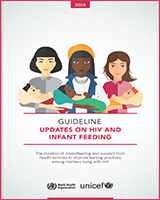Breastfeeding is one of the foundations of child health, development and survival, especially where diarrhoea, pneumonia and undernutrition are common causes of mortality among children younger than five years. For these reasons, exclusive breastfeeding for the first six months of life is the recommended way of feeding infants, followed by continued breastfeeding with appropriate complementary foods for up to two years or beyond (WHO, 2016b). Action is needed at the policy level, in the workplace, in health systems and in the community to provide an enabling environment for women to be able to breastfeed as recommended. The WHO Global Strategy for Infant and Young Child Feeding (WHO, 2003) describes the essential interventions to protect, promote and support breastfeeding. In southern and eastern Africa, where child mortality rates are among the highest in the world, HIV infection is common and is a leading cause of death. In these settings, use of commercial breast-milk substitutes and other replacement feeds among non-HIV-exposed infants is associated with significantly increased morbidity and mortality. Moreover, the evidence for the long-term benefits of longer durations of breastfeeding for both maternal and child health outcomes, including child development and preventing noncommunicable diseases, highlights the relevance of supporting breastfeeding in high- and low-income settings alike.
In 2010, WHO for the first time recommended ARV drug interventions to prevent postnatal transmission of HIV through breastfeeding (WHO, 2010c). Before this, WHO guidance on HIV and infant feeding (UNICEF et al., 2003; WHO et al., 2006) recommended an individualized approach in which women living with HIV would be counselled on feeding options according to their household circumstances. In 2010, WHO adopted a public health approach, recommending that national authorities promote and support one feeding practice for all women living with HIV accessing care in public health facilities. This was a major paradigm shift. The 2010 guidelines also explained how to protect, promote and support breastfeeding in the general population to avoid undermining optimal infant feeding practices in women and mothers not affected by HIV. The updated HIV and infant feeding: framework for priority action (WHO, 2012a) provided guidance to governments on key actions to create and sustain an environment that encourages appropriate feeding practices for all infants and young children, including implementation of the International Code of Marketing of Breast-milk Substitutes to protect mothers and communities from unethical marketing practices and commercial pressures, while scaling up interventions to reduce HIV transmission.
Since then, countries have largely implemented the WHO guidelines on HIV and infant feeding in accordance with the 2010 recommendations. These guidelines have not been updated since that time, since little new evidence emerged on either the uptake or impact of the recommendations in the first years following their release. However, the WHO consolidated guidelines on the use of ARV drugs for treating and preventing HIV infection were updated in 2013 and again in 2016 (WHO, 2013, 2016c). WHO now recommends lifelong ART for all from the time when any adult (including pregnant and breastfeeding women) or child is first diagnosed with HIV infection. This undertaking requires long-term planning and coordination by national health authorities and commitment from international agencies to assist with funding and support to health systems. Reducing HIV-related mortality among adults and children and preventing the vertical transmission of HIV to children will require sustainable approaches to assure the supply of ARV drugs and improve counselling and support to individuals to optimize adherence and retention in care.
The revisions to the ARV drug guidelines, recent evidence and programmatic experience and demand for clarification on specific issues created a need to review the HIV and infant feeding guidelines.
Target audience
The target audience for this guideline includes: (1) national policy-makers in health ministries; (2) programme managers working in child health, essential drugs and health worker training; (3) health-care providers, researchers and clinicians providing services to pregnant women and mothers living with HIV at various levels of health care; and (4) development partners providing financial and/or technical support for child health programmes, including those in conflict and emergency settings.
Population of interest
This guideline is intended mainly for countries with high HIV prevalence and settings where diarrhoea, pneumonia and undernutrition are common causes of infant and child mortality. It may also be relevant to settings with a low prevalence of HIV depending on background rates and causes of infant and child mortality. It should assist health workers providing support to mothers living with HIV who may choose to breastfeed even if this is not the primary recommendation of their national and local health authority.
Priority questions for review
In November 2014, a WHO Guideline Development Group (see the list of experts in the acknowledgements) reviewed the 2010 guidelines on HIV and infant feeding and identified specific questions that should be updated based on new evidence and programmatic experience. Four areas were given priority for review:
the duration of breastfeeding by mothers living with HIV;
interventions to support infant feeding practices by mothers living with HIV;
what to advise when mothers living with HIV do not exclusively breastfeed (if a mother living with HIV does not exclusively breastfeed, is mixed feeding with ART better than no breastfeeding at all?); and
what to advise when mothers living with HIV do not plan to breastfeed for 12 months (if a mother living with HIV plans to return to work or school, is a shorter duration of planned breastfeeding with ART better than no breastfeeding at all?).
Guided by this process and in consultation with the international experts, each question was described in terms of its characteristics: population, intervention, comparison and outcome (PICO). For each priority question, outcomes that were deemed to be either critical or important were evaluated. See Annex 5.

